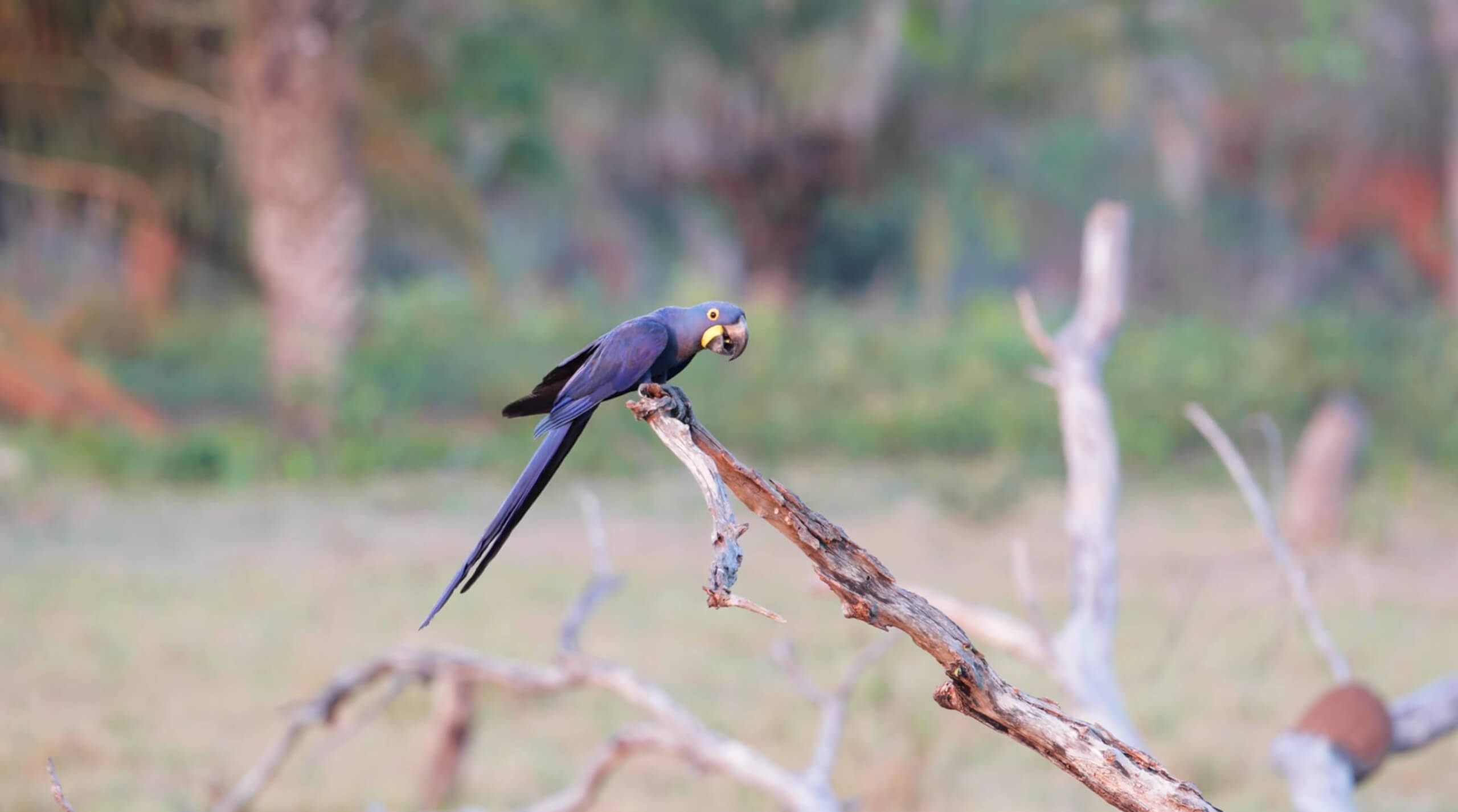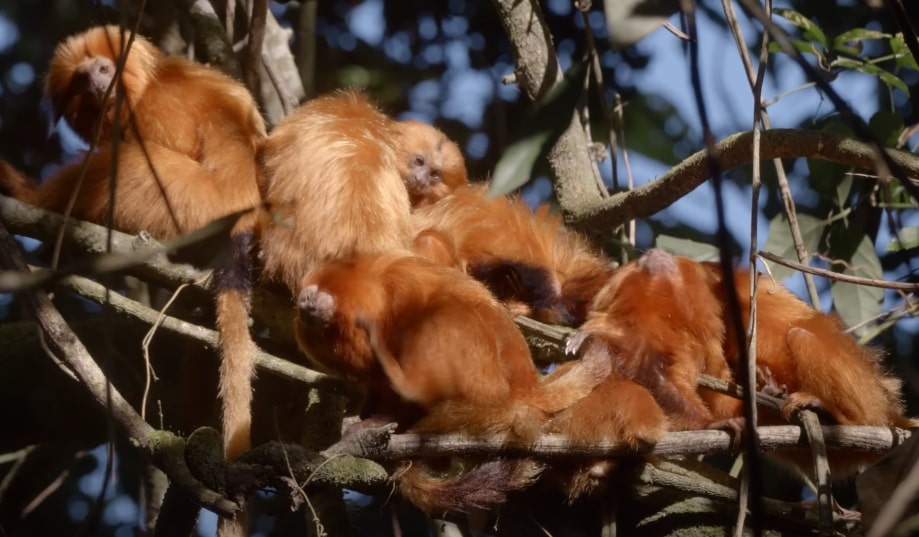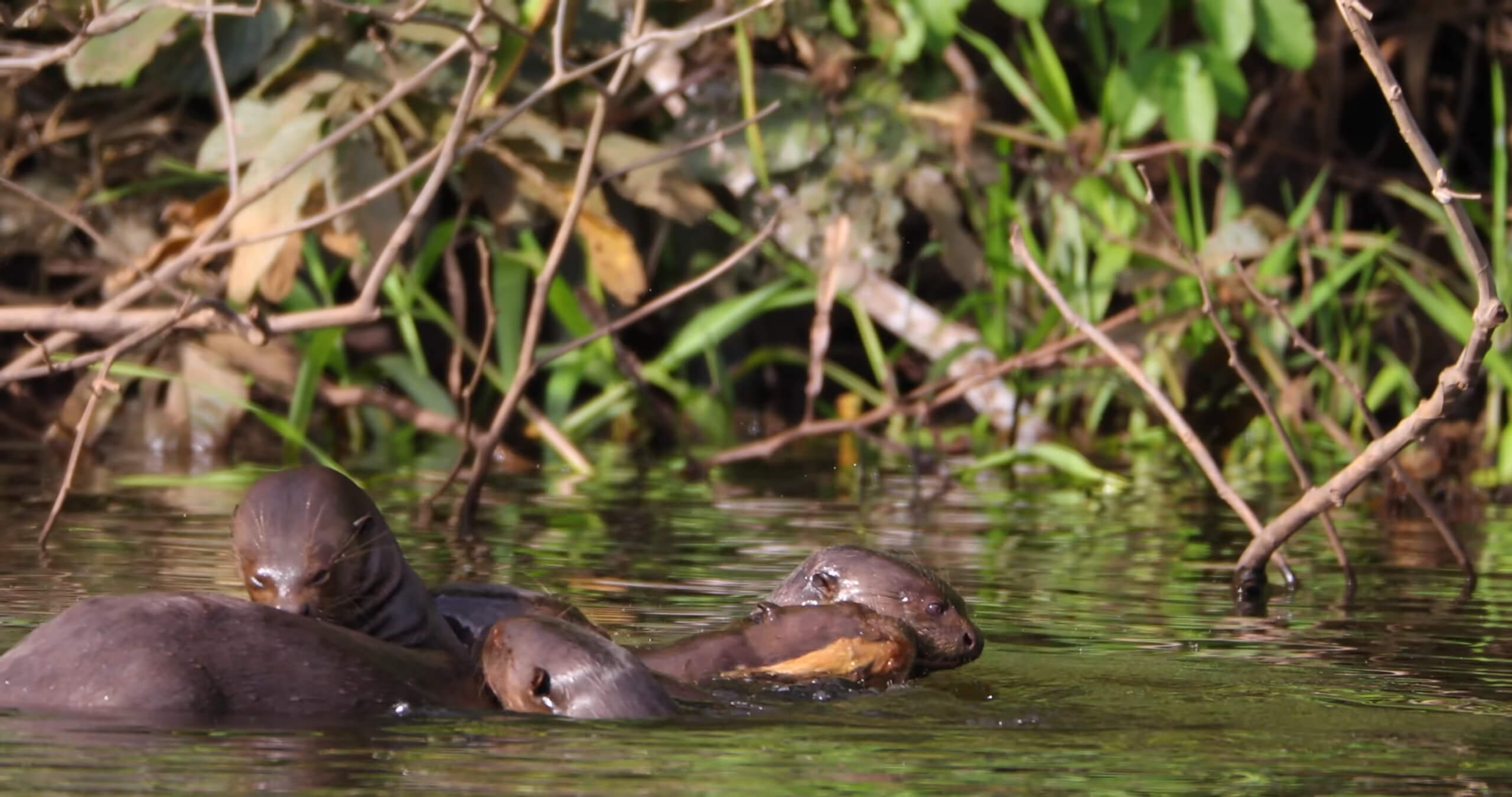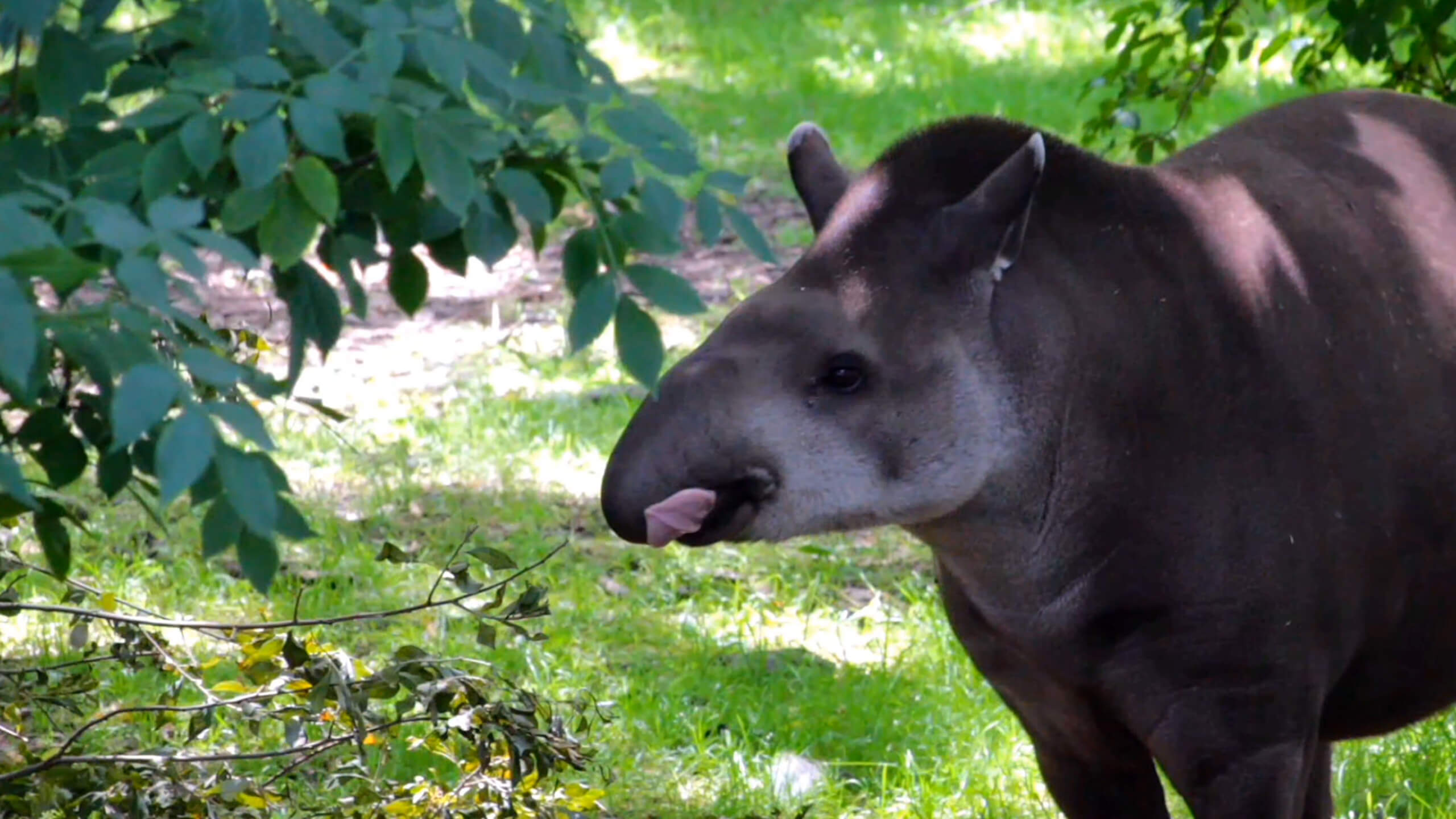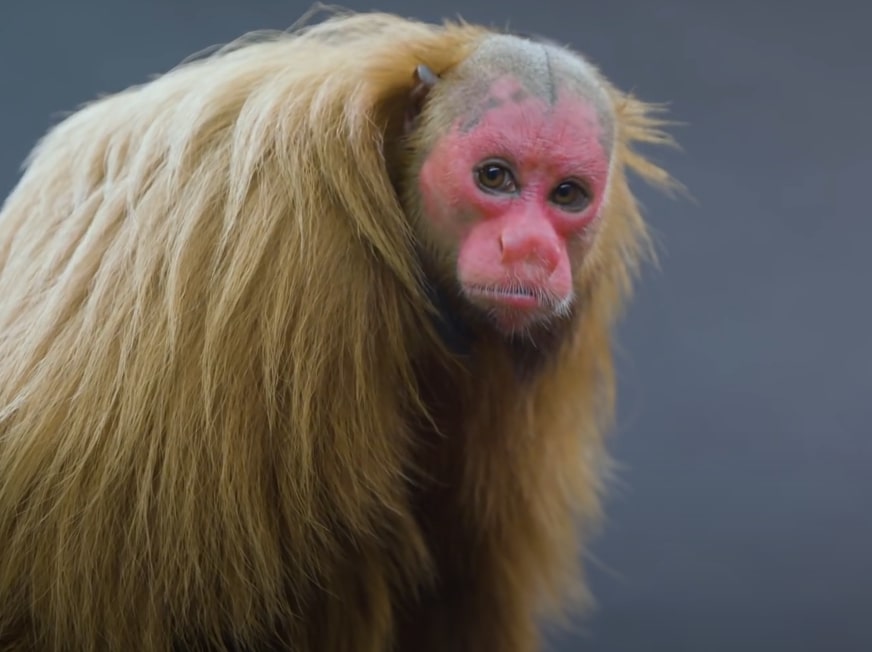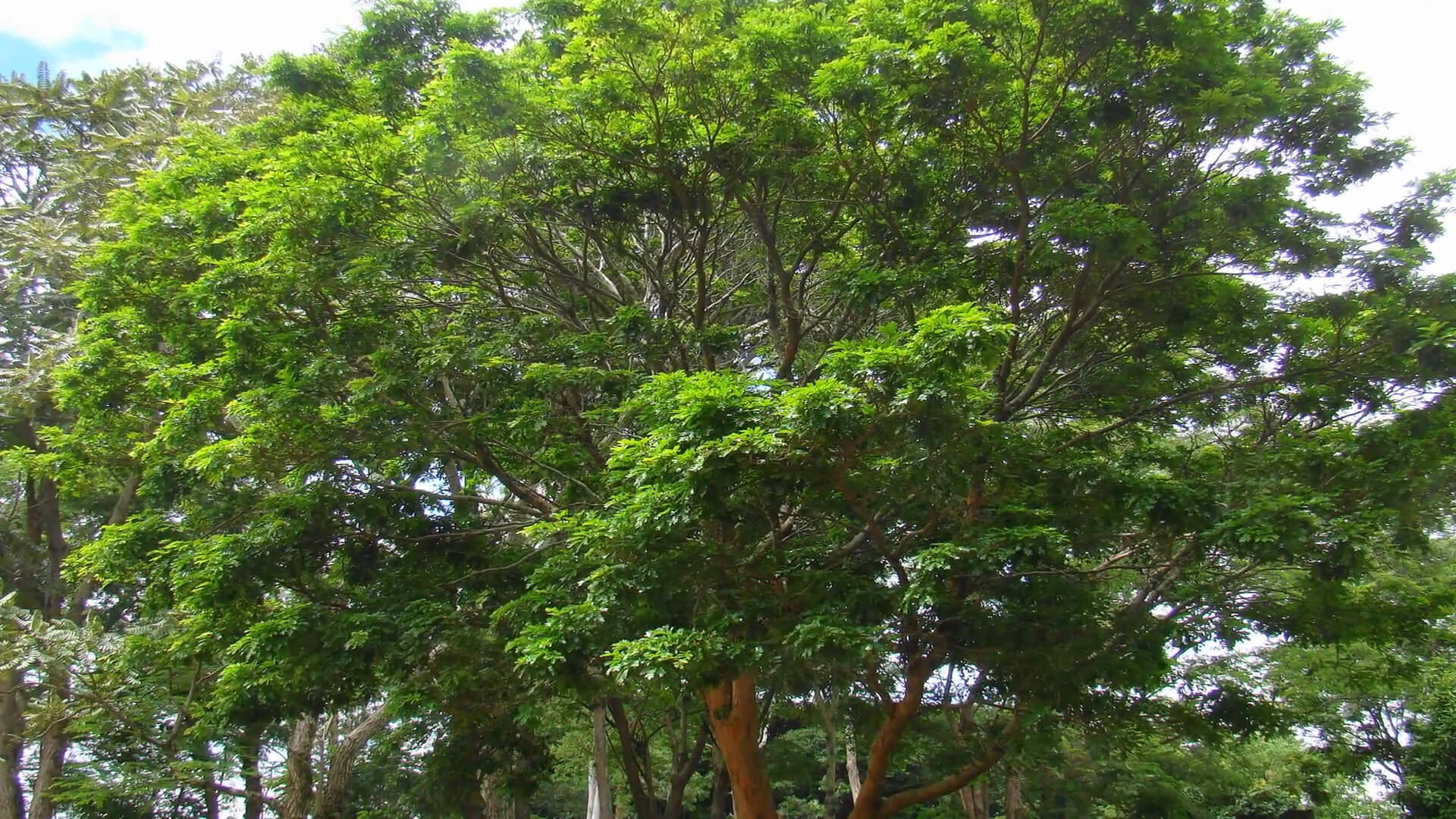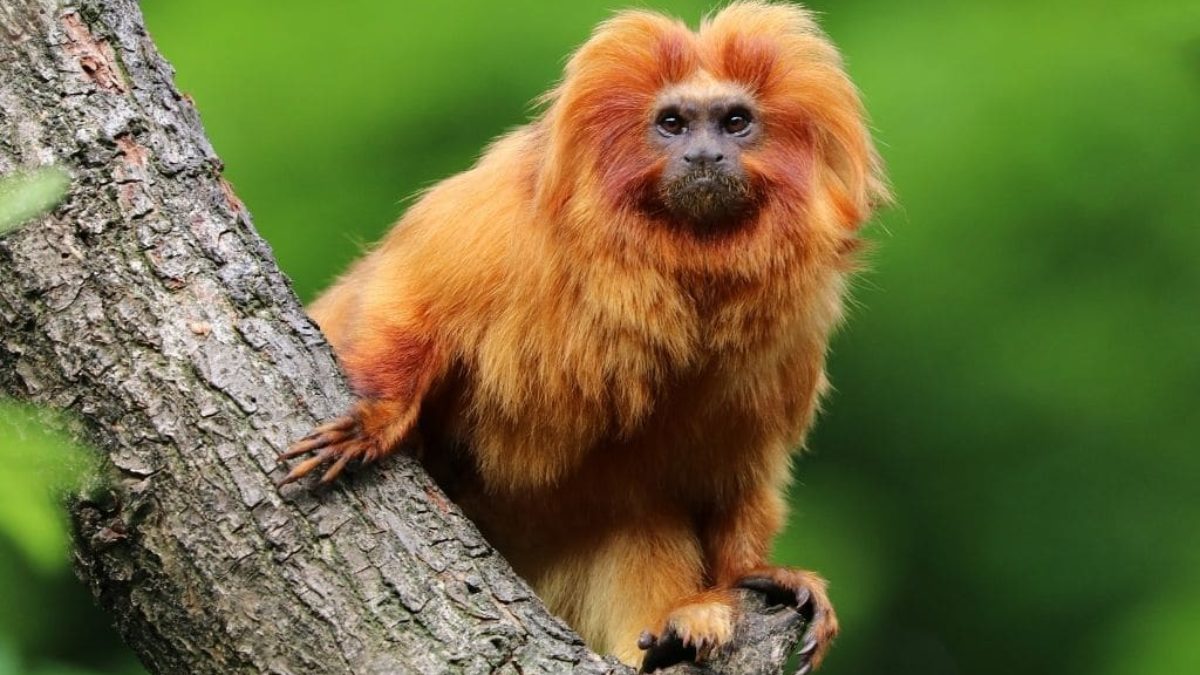
Brazil is home to some of the most unique wildlife on the planet, making it a hotspot for biodiversity.
However, many of the native animals face the threat of extinction due to deforestation, habitat loss, and human activities. There are some endangered species you should know about.
This article explores seven endangered species in Brazil you should know about.
Endangered Species in Brazil
- Northern Muriqui
- Hyacinth Macaw
- Golden Lion Tamarin
- Giant Otter
- South American Tapir
- Uakari Monkey
- Brazilwood Tree
1. Northern Muriqui
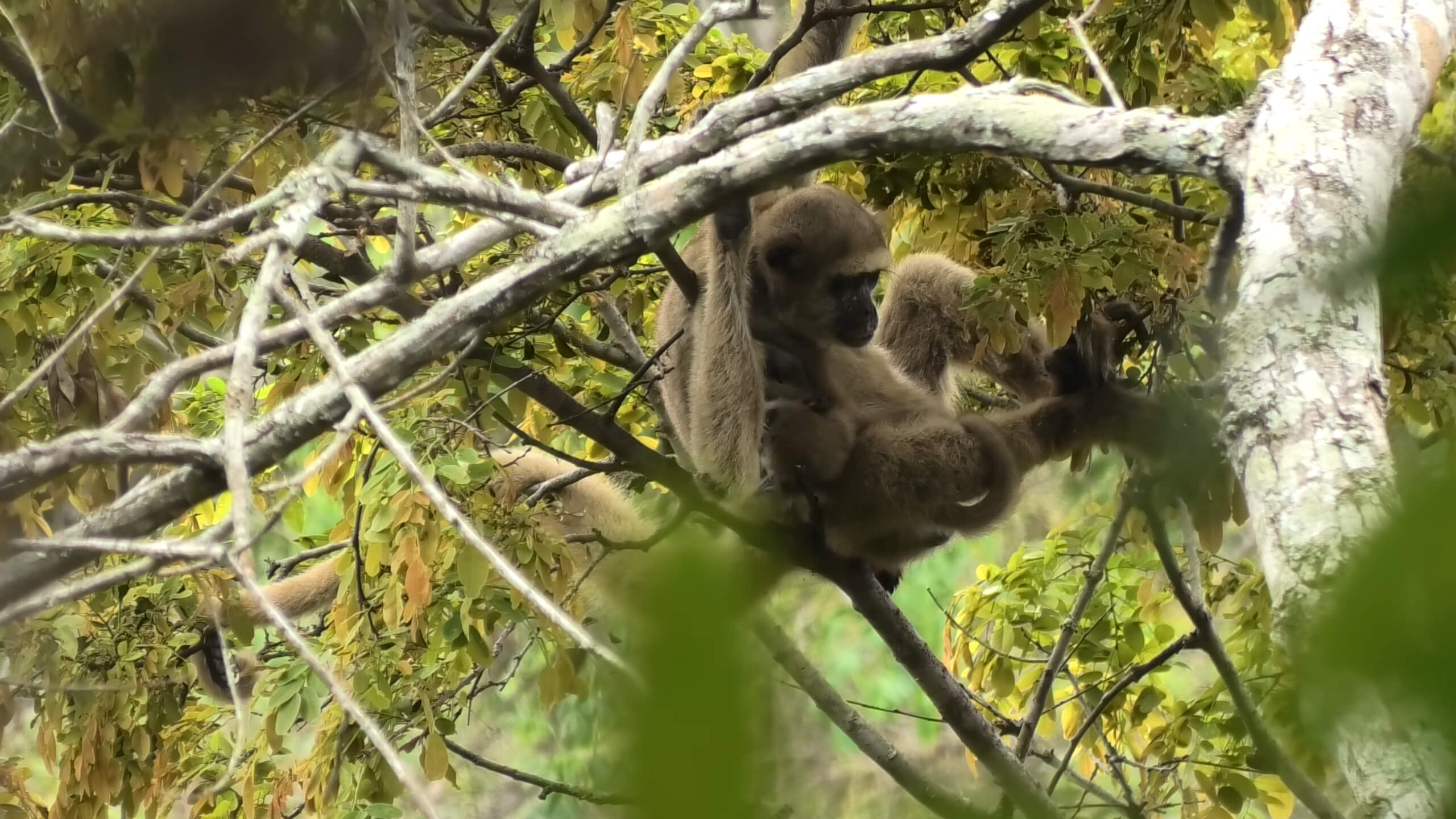
| Scientific Name | Brachyteles hypoxanthus |
|---|---|
| Status | Critically Endangered |
| Habitat | Atlantic Forest, Brazil |
| Threats | Deforestation, Habitat Loss, Hunting |
The Northern Muriqui, one of the largest primates in Brazil, has been critically endangered for decades.
Found in the rapidly disappearing Atlantic Forest, this species is known for its peaceful nature and strong social bonds. It is native to Brazil and plays a crucial role in maintaining forest ecosystems by dispersing seeds.
Deforestation and fragmentation of Brazil’s Atlantic Forest have devastated the Northern Muriqui’s population.
What was once a widespread species is now limited to small, isolated pockets in protected areas.
The rapid urbanization, expansion of agriculture, and illegal logging have reduced this forest to less than 10% of its original size, severely impacting animals in Brazil, including the Northern Muriqui.
The decline of this species has been documented since the 1990s, but conservation efforts face challenges due to limited funding and the complex nature of restoring fragmented habitats.
The species is also targeted by hunters, further reducing its numbers. Despite being Brazil’s national animal in terms of its significance to the ecosystem, the Northern Muriqui is at high risk of extinction if habitat protection does not improve.
Brazilian animals like the Northern Muriqui are essential to the biodiversity of South America. Protecting them requires not only the conservation of existing forest fragments but also efforts to reconnect isolated populations and enforce stricter anti-poaching laws.
If you are planning to visit Brazil, I have to add that their national food is also amazing. Also check out the best cities for food lovers in Brazil.
2. Hyacinth Macaw
| Scientific Name | Anodorhynchus hyacinthinus |
|---|---|
| Status | Vulnerable |
| Habitat | Pantanal, Amazon Rainforest, Brazil |
| Threats | Deforestation, Illegal Pet Trade, Habitat Loss |
The Hyacinth Macaw, also known as Brazil’s big bird due to its impressive size and striking blue color, is the largest flying parrot in the world.
Found primarily in the Pantanal and Amazon Rainforest, this species is a symbol of the rich diversity of Brazilian animals.
Despite its importance, the Hyacinth Macaw faces growing threats, leading to its classification as vulnerable.
Deforestation has significantly reduced the number of nesting sites available for these macaws.
The clearing of Brazil’s forests for agriculture and urban development has fragmented their habitat, making survival increasingly difficult.
Additionally, the illegal pet trade is a major issue, with poachers targeting this bird for its unique beauty and high market value.
While the Hyacinth Macaw is not yet critically endangered, its population has been declining steadily over the past few decades.
Conservation efforts have included habitat protection and breeding programs, but the species still faces considerable risks.
Preserving this bird is essential, not just as a national symbol, but as part of the effort to protect animals in Brazil that are vital to the ecosystem.
As one of the most iconic animals native to South America, the Hyacinth Macaw’s future depends on continued conservation initiatives and strict enforcement of laws to combat illegal wildlife trade.
Observing this interesting parrot is surely a great reason to visit Brazil, but there are many other impressive things you can see in this country.
If you are interested in historic monuments and museums, visit Brasilia.
3. Golden Lion Tamarin
| Scientific Name | Leontopithecus rosalia |
|---|---|
| Status | Endangered |
| Habitat | Atlantic Forest, Brazil |
| Threats | Habitat Loss, Fragmentation, Illegal Pet Trade |
The Golden Lion Tamarin is one of the most recognized animals in Brazil due to its vibrant orange fur and small size.
Found exclusively in the Atlantic Forest, this primate is a flagship species for conservation in the region.
Its population once declined drastically due to the widespread destruction of Brazil’s Atlantic Forest, which is home to many of the country’s unique species.
By the 1980s, the Golden Lion Tamarin was on the brink of extinction, with fewer than 200 individuals left in the wild.
Habitat fragmentation made it difficult for the species to maintain stable populations, as isolated patches of forest couldn’t support long-term survival.
Additionally, the illegal pet trade posed a significant threat, with these tamarins being captured for their striking appearance.
Over the past few decades, intensive conservation efforts have helped stabilize the population.
However, the species remains endangered due to ongoing deforestation and the limited connectivity between forest patches.
Brazil’s national animal conservation initiatives have been crucial in safeguarding this and other Brazilian animals, but continued vigilance is necessary.
If you are planning to visit Brazil, keep in mind that English is not among the most spoken languages.
4. Giant Otter
| Scientific Name | Pteronura brasiliensis |
|---|---|
| Status | Endangered |
| Habitat | Amazon Basin, Pantanal Wetlands |
| Threats | Water Pollution, Habitat Loss, Illegal Hunting |
The Giant Otter is one of the most fascinating animals in Brazil, known for its large size and social behavior. Native to the Amazon Basin and the Pantanal wetlands, this species plays an important role in the aquatic ecosystems of South America.
Despite its status as a key predator, the Giant Otter is now endangered due to several factors impacting its habitat.
Water pollution is a significant threat, especially from mining and agricultural activities that contaminate the rivers and wetlands where the otters live.
Habitat destruction through deforestation and the expansion of farmland has also greatly reduced the available territory for these animals.
Additionally, illegal hunting for their pelts was once a major issue, leading to a dramatic population decline during the 20th century.
The Giant Otter’s decline has been evident since the 1970s, when extensive hunting and environmental degradation brought the species to near extinction.
Although hunting is now illegal and protected areas have been established, Brazil animals like the Giant Otter continue to struggle due to ongoing habitat challenges.
5. South American Tapir
| Scientific Name | Tapirus terrestris |
|---|---|
| Status | Vulnerable |
| Habitat | Amazon Rainforest, Atlantic Forest, Pantanal |
| Threats | Deforestation, Habitat Loss, Hunting |
The South American Tapir is one of the oldest and most recognizable animals in Brazil. Often compared to a pig due to its shape, this herbivore plays a crucial role in forest ecosystems by dispersing seeds and maintaining plant diversity.
The tapir is native to various habitats, including the Amazon Rainforest and the Pantanal wetlands.
Deforestation remains the primary threat to the South American Tapir, especially in areas like the Amazon, where rapid agricultural expansion is destroying vast stretches of forest.
As Brazil’s national animal conservation efforts focus more on high-profile species, the tapir’s importance is often overlooked despite its essential role in the environment.
Illegal hunting is another significant issue. Although the tapir is protected by law, its large size and slow movements make it an easy target for hunters.
The animal’s population has been declining since the mid-20th century, and without strong enforcement and habitat protection, the species faces a bleak future.
If you are more into beaches and relaxing, then Florianopolis, Brazil, will be interesting to read about. Also, if you are looking for some unique festivals and events, then Paraty should be on your travel list.
6. Uakari Monkey
| Scientific Name | Cacajao calvus |
|---|---|
| Status | Vulnerable |
| Habitat | Amazon Rainforest, Brazil |
| Threats | Deforestation, Hunting, Habitat Loss |
The Uakari Monkey is one of the most distinctive animals in Brazil, easily recognized by its bright red face and bald head.
Native to the Amazon Rainforest, this monkey species plays a significant role in seed dispersal, making it crucial for maintaining the health and diversity of the forest ecosystem.
The main threat to the Uakari Monkey is deforestation, which continues to destroy large portions of its habitat in the Amazon.
The rapid expansion of agriculture, logging, and human settlements has led to significant habitat loss, isolating populations and reducing their ability to thrive.
Illegal hunting further exacerbates the decline, as these monkeys are often targeted for bushmeat in some regions.
Despite being one of the lesser-known Brazilian animals, the Uakari Monkey’s conservation status has been vulnerable for several decades.
Efforts to protect this species have included establishing protected areas within the Amazon and promoting sustainable land use practices.
However, the ongoing deforestation crisis makes it challenging to ensure the long-term survival of this species.
As one of the unique animals native to South America, the Uakari Monkey’s future depends on enhanced conservation initiatives and stricter enforcement against illegal hunting.
It remains an important part of Brazil’s biodiversity and contributes to the rich variety of Brazil animals that make the country’s ecosystems so diverse.
If you want to combine beautiful beaches with various activities like scuba diving, snorkeling, and more, then you should check out Buzios Brazil.
7. Brazilwood Tree
| Scientific Name | Paubrasilia echinata |
|---|---|
| Status | Critically Endangered |
| Habitat | Atlantic Forest, Brazil |
| Threats | Deforestation, Illegal Logging |
The Brazilwood Tree, known locally as “Pau-Brasil,” holds significant cultural and historical importance, as it gave Brazil its name. This tree was once abundant along the coastal regions of Brazil, primarily in the Atlantic Forest.
However, centuries of logging for its valuable red dye, along with the expansion of agriculture and urbanization, have brought the species to the brink of extinction.
The Brazilwood Tree has been among critically endangered species since the early 20th century due to excessive logging and habitat loss.
Deforestation has reduced the Atlantic Forest to just a fraction of its original size, threatening the survival of this and many other animals native to South America that depend on forest ecosystems.
Conservation efforts have focused on reforestation and protecting remaining tree populations, but illegal logging remains a persistent threat. Although the Brazilwood Tree is protected under Brazilian law, enforcement challenges have allowed illegal activities to continue.
The species is also under pressure from urban expansion and land conversion for agriculture, leaving only small pockets of its native habitat intact.
If you want to experience a different climate compared to most parts of the country, you should visit Santa Catarina, the only place in Brazil where snow is not so rare.
FAQs
What are some fun facts about Brazil?
Brazil is the largest country in South America, home to the Amazon Rainforest, and boasts diverse wildlife and cultures. It’s the only country in South America where Portuguese is the official language. Brazil is also famous for its annual Carnival, the Amazon River, and being the birthplace of several world-renowned football players. The country is home to many unique animals in Brazil, like the jaguar, capybara, and giant anteater. There are many other fun facts about Brazil for you to check out.
What is the best time to travel to Brazil?
The best time to visit Brazil depends on your destination. If you plan to explore the Amazon Rainforest, the dry season (June to November) offers easier access to trails and wildlife sightings. For those visiting Rio de Janeiro or other coastal regions, December to March provides warm weather perfect for beaches. Brazil’s varied climate means there’s something to experience year-round, but research based on the specific region you wish to visit is recommended.
What are the best cities to stay near the Amazon River?
Manaus is the top choice for travelers looking to explore the Amazon River. As the largest city in the Amazon region, Manaus offers easy access to river tours, jungle lodges, and local attractions. Santarém and Belém are also good options, each offering different experiences while staying close to the river and surrounding forests. These cities provide excellent bases for exploring the diverse wildlife and natural beauty that the Amazon region has to offer. Natal is also close, and the advantage here is that you can also enjoy some beautiful beaches.
Can I observe Brazil’s endangered species in their natural habitat?
Yes, many tours allow travelers to observe Brazil’s endangered species in their natural habitats. The Pantanal is one of the best places to spot the jaguar, while the Amazon Rainforest offers chances to see the Uakari Monkey, Giant Otter, and various other animals native to South America. However, ethical and sustainable tourism practices are essential to ensure these species are not further disturbed. Many guided tours focus on conservation and education to promote responsible wildlife observation.
Can tourists travel to the Amazon Forest?
Yes, tourists can visit the Amazon Forest. Manaus is the main gateway for Amazon tours, offering everything from river cruises to guided jungle treks. There are numerous eco-lodges within the forest, providing immersive experiences in nature. Tourists can explore the vast biodiversity of the region while learning about Brazil’s national animal conservation efforts. However, it’s important to travel with licensed and reputable operators who prioritize sustainability and the protection of this fragile ecosystem.
Last Words
Protecting these endangered species is essential not only for Brazil but for the global environment.
Each species plays a unique role in maintaining the balance of ecosystems, from the towering trees of the Atlantic Forest to the vibrant creatures of the Amazon.
Continued conservation efforts and responsible human practices are key to preserving these species for future generations.

